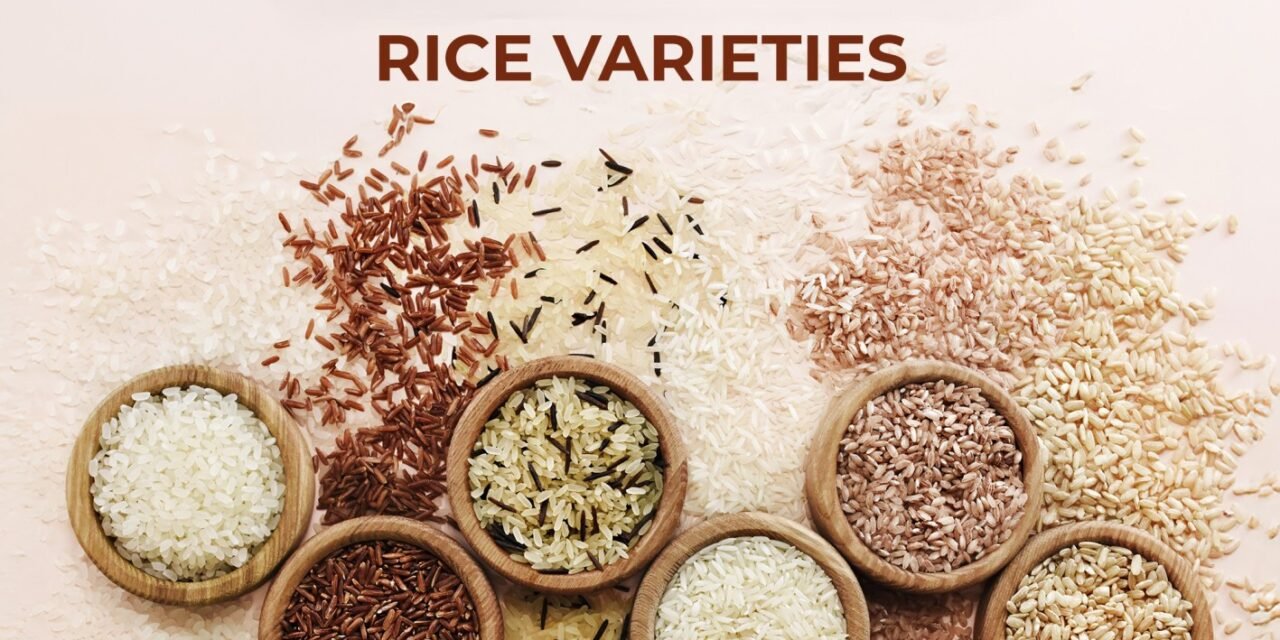Rice, a staple food for over half of the world’s population, comes in numerous varieties, each with unique characteristics, culinary uses, and nutritional profiles. These varieties are generally classified based on grain size, texture, color, and processing methods. Here is an overview of the major types of rice grown globally and their nutritional profiles:
1. Long-Grain Rice
Examples: Basmati, Jasmine, Carolina
- Characteristics: Long, slender grains that stay separate and fluffy when cooked.
- Culinary Uses: Used in pilafs, biryanis, stir-fries, and side dishes.
- Nutritional Profile (per 100g, cooked):
- Calories: ~130
- Carbohydrates: ~28g
- Protein: ~2.5g
- Fiber: ~0.3g
- Fat: ~0.2g
- Key Varieties:
- Basmati Rice: Known for its fragrant aroma, it is used in South Asian cuisines.
- Jasmine Rice: A fragrant rice popular in Thai and Southeast Asian dishes.
2. Medium-Grain Rice
Examples: Arborio, Valencia, Calrose
- Characteristics: Shorter and plumper than long-grain rice, becoming soft and slightly sticky when cooked.
- Culinary Uses: Ideal for risotto, paella, and sushi.
- Nutritional Profile (per 100g, cooked):
- Calories: ~130
- Carbohydrates: ~28g
- Protein: ~2.4g
- Fiber: ~0.4g
- Fat: ~0.3g
- Key Varieties:
- Arborio Rice: Known for its creamy texture in risottos.
- Calrose Rice: A sticky rice commonly used in Asian and Hawaiian cuisines.
3. Short-Grain Rice
Examples: Sushi Rice, Mochigome
- Characteristics: Round grains that become very sticky and clump together when cooked.
- Culinary Uses: Commonly used for sushi, desserts, and puddings.
- Nutritional Profile (per 100g, cooked):
- Calories: ~130
- Carbohydrates: ~28g
- Protein: ~2.3g
- Fiber: ~0.3g
- Fat: ~0.3g
- Key Varieties:
- Sushi Rice: Used in Japanese cuisine for sushi rolls.
- Glutinous Rice: Sticky rice used in Asian desserts and dumplings.
4. Brown Rice
Examples: Brown Basmati, Short-Grain Brown Rice
- Characteristics: Whole-grain rice with the bran layer intact, giving it a nutty flavor and chewy texture.
- Culinary Uses: Used in salads, grain bowls, and as a healthier alternative to white rice.
- Nutritional Profile (per 100g, cooked):
- Calories: ~112
- Carbohydrates: ~23g
- Protein: ~2.5g
- Fiber: ~1.8g
- Fat: ~0.9g
- Health Benefits:
- High in fiber and antioxidants.
- Contains more magnesium, selenium, and B vitamins than white rice.
5. Black Rice
Examples: Forbidden Rice, Thai Black Rice
- Characteristics: Dark, purplish-black color due to anthocyanins, with a nutty flavor and chewy texture.
- Culinary Uses: Used in salads, desserts, and gourmet dishes.
- Nutritional Profile (per 100g, cooked):
- Calories: ~150
- Carbohydrates: ~34g
- Protein: ~5g
- Fiber: ~3g
- Fat: ~0.5g
- Health Benefits:
- High in antioxidants, especially anthocyanins.
- Rich in iron and fiber.
6. Red Rice
Examples: Bhutanese Red Rice, Camargue Red Rice
- Characteristics: Reddish hue due to its high anthocyanin content, with a nutty flavor and chewy texture.
- Culinary Uses: Used in salads, side dishes, and as a base for protein-rich meals.
- Nutritional Profile (per 100g, cooked):
- Calories: ~110
- Carbohydrates: ~23g
- Protein: ~2.6g
- Fiber: ~1.8g
- Fat: ~0.7g
- Health Benefits:
- Rich in antioxidants, zinc, and iron.
- Helps regulate blood sugar levels.
7. Wild Rice
Examples: North American Wild Rice
- Characteristics: Not technically rice, but the seeds of aquatic grass; long, dark, and chewy grains.
- Culinary Uses: Often mixed with other grains in pilafs or served as a side dish.
- Nutritional Profile (per 100g, cooked):
- Calories: ~101
- Carbohydrates: ~21g
- Protein: ~4g
- Fiber: ~1.8g
- Fat: ~0.3g
- Health Benefits:
- High in protein and antioxidants.
- Rich in magnesium, phosphorus, and zinc.
8. Parboiled Rice
- Characteristics: Rice that has been partially boiled in its husk, making it more nutritious than white rice but less so than brown rice.
- Culinary Uses: Common in traditional dishes where firm, separate grains are needed.
- Nutritional Profile (per 100g, cooked):
- Calories: ~123
- Carbohydrates: ~26g
- Protein: ~2.4g
- Fiber: ~0.9g
- Fat: ~0.3g
- Health Benefits:
- Retains more vitamins and minerals than white rice due to the parboiling process.
- Lower glycemic index than white rice.
9. White Rice
- Characteristics: Milled to remove the bran and germ, resulting in a polished white grain.
- Culinary Uses: Widely used in cuisines globally due to its neutral flavor and soft texture.
- Nutritional Profile (per 100g, cooked):
- Calories: ~130
- Carbohydrates: ~28g
- Protein: ~2.4g
- Fiber: ~0.2g
- Fat: ~0.2g
- Health Benefits:
- Easily digestible and suitable for those with sensitive stomachs.
- Fortified versions contain added nutrients like iron and folic acid.
Conclusion
The variety of rice available globally caters to different culinary needs and nutritional preferences. While white rice is the most widely consumed, whole-grain options like brown, black, red, and wild rice are gaining popularity for their superior nutritional profiles and health benefits. The choice of rice depends on dietary goals, cultural preferences, and culinary applications.
Hashtags
#RiceHarvest #FarmToTable #RiceRecipes #RiceLovers #RiceFields #RiceFarming #RiceCulture #RiceDishes #RiceBenefits #RiceProduction #RiceEconomy #RiceVarieties #RiceConsumption #RiceSustainability #RiceHealthBenefits #RiceDiversity #RiceTrade #RiceConsumers #RiceInnovation #RiceSolutions









